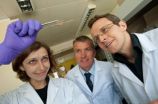(Press-News.org) Excess fat around the hips and belly may not really be compatible with current beauty ideals, but, to a certain degree, it is a normal, even vital energy store of our body. However, it is a different matter if the organism stores fat in organs such as the liver, pancreas or muscles. This is a clear sign of a metabolic disorder.
Up to 80 percent of obese people develop fatty liver disease, which is regarded a typical characteristic of the dangerous metabolic syndrome. Deposition of fat in the liver may lead to chronic liver inflammation and even to liver cancer. In addition, fatty liver is considered to be an independent risk factor for coronary heart disease and atherosclerosis.
The great medical relevance of fatty liver as a severe condition accompanying insulin resistance and type II diabetes caused the research group headed by Dr. Stephan Herzig of the Division of Molecular Metabolic Control to investigate how this syndrome arises. Which molecular switches are turned on or off in a cell when food delivers too much energy-rich fat molecules, or triglycerides?
To this end, the investigators determined the level of particular proteins involved in specific gene activation in the liver tissue of mice. These proteins, which are known as transcriptional co-activators, regulate which proteins are read and transcribed into messenger RNA molecules in a cell. In overweight mice, the researchers observed that a high triglyceride level in the liver was always associated with reduced production of a co-activator called TBL1. This was found both in animals that developed fatty liver for hereditary reasons and in those animals that received calorie-rich food.
TBL1 was originally discovered in connection with a rare hereditary hearing disorder. In the liver, but not in other tissues, an oversupply of fat reduces the production of TBL1. As a result, fat burning in the liver is reduced so that more fat molecules are deposited in liver cells. "This, in turn, may lead to a further reduction of TBL1," says Stephan Herzig.
Not only in mice is TBL1 linked to the liver fat (lipid) metabolism. The group found the same pattern in human liver tissue samples: the higher their triglyceride levels, the lower their TBL1 levels.
Stephan Herzig expects a practical use of these results. "We might be able in the future to use TBL1 levels for identifying those obese persons who have a special risk of developing fatty liver. We could then give specific dietary recommendations to counteract this."
INFORMATION:
Philipp Kulozik, Allan Jones, Frits Mattijssen, Adam J. Rose, Anja Reimann, Daniela Strzoda, Stefan Kleinsorg, Christina Raupp, Jürgen Kleinschmidt, Karin Müller-Decker, Walter Wahli, Carsten Sticht, Norbert Gretz, Christian von Loeffelholz, Martin Stockmann, Andreas Pfeiffer, Sigrid Stöhr, Geesje M. Dallinga-Thie, Peter P. Nawroth, Mauricio Berriel Diaz and Stephan Herzig: Hepatic deficiency in transcriptional co-factor TBL1 promotes liver steatosis and hypertriglyceridemia. Cell Metabolism, 2011, DOI: 10.1016/j.cmet.2011.02.011
A picture is available on the Internet:
http://www.dkfz.de/de/presse/pressemitteilungen/2011/images/Liver.jpg
Picture caption: 3D-illustration of a human liver with blood vessels (red and blue) and bile duct (green)
Source: Prof. Dr. Hans-Peter Meinzer, Deutsches Krebsforschungszentrum
The German Cancer Research Center (Deutsches Krebsforschungszentrum, DKFZ), employing over 2,500 staff members, is the largest biomedical research institute in Germany. More than 1,000 scientists are working to investigate the mechanisms of cancer development, identify cancer risk factors and develop new strategies for better cancer prevention, more precise diagnosis and effective treatment of cancer patients. In addition, the staff of the Cancer Information Service (KID) provides information about this widespread disease for patients, their families, and the general public. DKFZ is funded by the German Federal Ministry of Education and Research (90%) and the State of Baden-Wuerttemberg (10%) and is a member of the Helmholtz Association of National Research Centers.
END
At Karlsruhe Institute of Technology (KIT), researchers of the DFG Center for Functional Nanostructures (CFN) succeeded in specifically cultivating cells on three-dimensional structures. The fascinating thing is that the cells are offered small "holds" in the micrometer range on the scaffold, to which they can adhere. Adhesion is possible to these holds only, not to the remaining structure. For the first time, cell adhesion and, hence, cell shape are influenced precisely in three dimensions. The team headed by Professor Martin Bastmeyer thus has achieved big progress in ...
Scientists have shed new light on how older people may lose their memory with a development that could aid research into treatments for age-related memory disorders.
Many believe that stress is bad for our brains especially as we get older. Now researchers have shown how two receptors in older brains react to a stress hormone called cortisol, which has been linked to increasing forgetfulness as we age.
The study, by the University of Edinburgh, found that one receptor was activated by low levels of cortisol, which helped memory.
However, once levels of this stress ...
Researchers at the University of Warwick have developed a gold plated window as the transparent electrode for organic solar cells. Contrary to what one might expect, these electrodes have the potential to be relatively cheap since the thickness of gold used is only 8 billionths of a metre. This ultra-low thickness means that even at the current high gold price the cost of the gold needed to fabricate one square metre of this electrode is only around £4.5. It can also be readily recouped from the organic solar cell at the end of its life and since gold is already widely ...
Long term users of the popular recreational drug ecstasy (MDMA) risk structural brain damage, suggests preliminary research published online in the Journal of Neurology, Neurosurgery and Psychiatry.
Other research has suggested that people who use ecstasy develop significant memory problems, so the Dutch researchers wanted to find out if there was any clinical evidence of structural changes in the brain to back this up.
They focused on the hippocampus, which is the area of the brain responsible for long term memory.
They measured the volume of the hippocampus using ...
Electronic medical records (EMRs) are garnering deeper use in the community hospital scene, and nearly all have been certified HITECH-ready by an official certification body. Nevertheless, a fifth of these hospitals plan to switch EMR products within the next couple of years -- even this close to meaningful use (MU) deadlines -- according to a new report by KLAS.
For the new report, "Community Hospital EMRs Maturing for Meaningful Use," KLAS interviewed more than 500 healthcare professionals about their experience with various EMR systems. Of respondents, 80 percent ...
A spot of regular retail therapy really does seem to help people live longer, suggests research published online in the Journal of Epidemiology and Community Health.
And it seems to benefit older men the most, the findings show.
The authors base their findings on almost 1,850 elderly (65+) Taiwanese people who were living independently at home, and included in the nationally representative Elderly Nutrition and Health Survey in Taiwan (NAHSIT Elderly), carried out in 1999-2000.
Participants were asked how often they went shopping, with options ranging from "never" ...
Epileptic seizures can precede the development of a subsequent brain tumour by many years, suggests research published online in the Journal of Neurology, Neurosurgery and Psychiatry.
The risk seems to be greatest among those aged between 15 and 44 when first admitted to hospital for an epileptic seizure, the findings show.
The researchers base their findings on first time admissions for epilepsy from the Oxford Record Linkage Study (ORLS) for 1963 to 1998, and national Hospital Episode Statistics (HES) data for England for 1999 to 2005.
These data were then linked ...
Financial Spreads, the UK-based spread betting company, has introduced another set of improvements for their clients.
This year Financial Spreads have already tightened their spreads on a number of popular markets in order to lower the cost of trading for clients. They have also introduced Guaranteed Stops in order to help clients with their risk management. The spread betting company has now introduced 'differential markets'.
Financial Spreads Spokesperson Adam Jepsen says that introducing differential markets not only offers account holders more choice, but better ...
Disease-causing bacteria carrying the new genetic resistance to antibiotics, NDM-1, have been discovered in New Delhi's drinking water supply.
A Cardiff University-led team found new strains of resistant bacteria in the Indian capital, including species which cause cholera and dysentery. The findings are the first evidence of the environmental spread of NDM-1, which had previously only been found in hospitals.
The scientists are calling for urgent action by health authorities worldwide to tackle the new strains and prevent their global spread. The Cardiff scientists ...
A new pathway has been discovered that links a common dietary lipid and intestinal microflora with an increased risk of heart disease, according to a Cleveland Clinic study published in the latest issue of Nature.
The study shows that people who eat a diet containing a common nutrient found in animal products (such as eggs, liver and other meats, cheese and other diary products, fish, shellfish) are not predisposed to cardiovascular disease solely on their genetic make-up, but rather, how the micro-organisms that live in our digestive tracts metabolize a specific lipid ...


